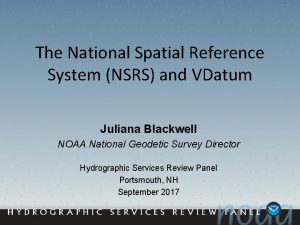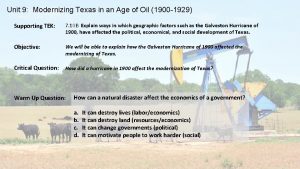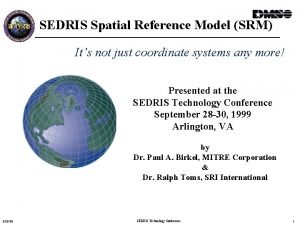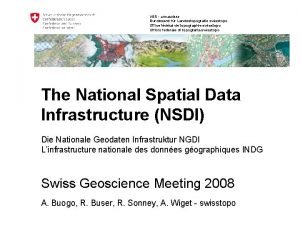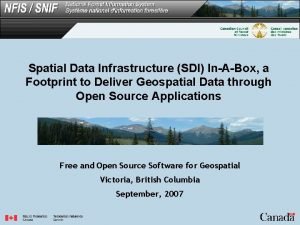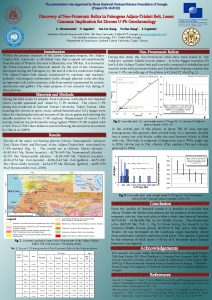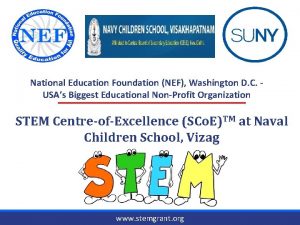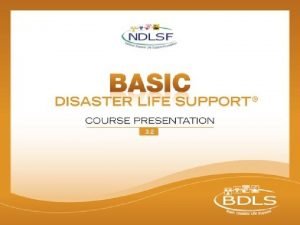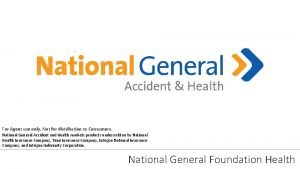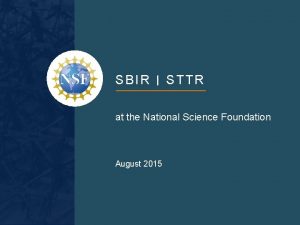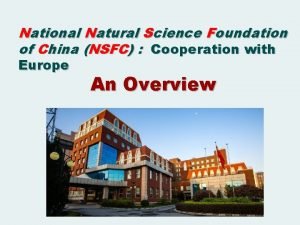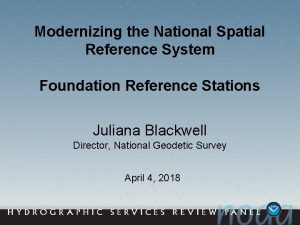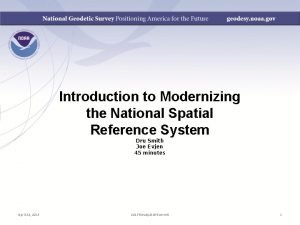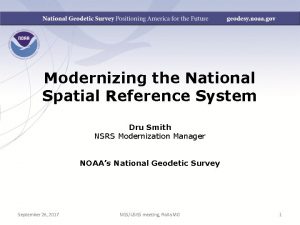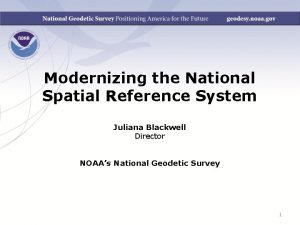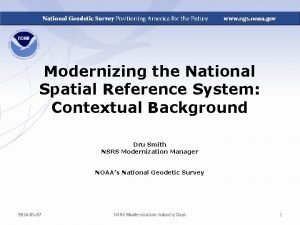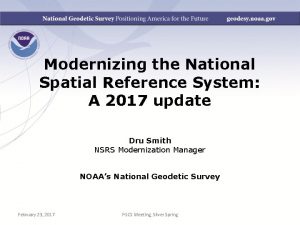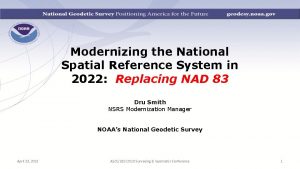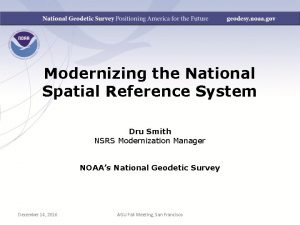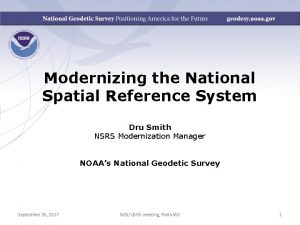Modernizing the National Spatial Reference System Foundation Reference













- Slides: 13

Modernizing the National Spatial Reference System Foundation Reference Stations Juliana Blackwell Director, National Geodetic Survey April 4, 2018

The National Geodetic Survey Ten-Year Plan Support the users of the National Spatial Reference System. Modernize and improve the National Spatial Reference System. Expand the National Spatial Reference System stakeholder base through partnerships, education, and outreach. Develop and enable a workforce with a supportive environment. Improve organizational and administrative functionality. https: //www. geodesy. noaa. gov/web/news/Ten_Year_Plan_2013 -2023. pdf 2

Replace the North American Datum of 1983 ACCESS AND DEFINITION Continuously Operating Reference Stations (CORS) Passive Control 3

Current Partnership Network • Consists of ~2000 Continuously Operating Reference Stations (CORS) • Run by more than 200 organizations (various government, academic, and private organizations) • Provides access to the U. S. National Spatial Reference System (NSRS) 4

NGS-owned CORS 5

Guiding Principles • By 2022, the National Spatial Reference System (NSRS) will be modernized with CORS becoming a more foundational component. • The International Earth Rotation and Reference Systems Service (IERS) International Terrestrial Reference System (ITRF) will continue to be the worldwide standard reference system. • NGS will continue to support the ITRF through International GNSS Service (IGS) reference sites. • The NSRS will continue to be defined in relation to the ITRF. 6

International GNSS Service (IGS) Network BARH WES 2 BRMU CNMR GUUG ASPA BRFT 7

NSRS Spans Four Tectonic Plates The North American Terrestrial Reference Frame of 2022 (NATRF 2022) to replace NAD 83 (2011) The Caribbean Terrestrial Reference Frame of 2022 (CATRF 2022) to replace NAD 83 (2011) The Pacific Terrestrial Reference Frame of 2022 (PATRF 2022) to replace NAD 83 (PA 11) The Mariana Terrestrial Reference Frame of 2022 (MATRF 2022) to replace NAD 83 (MA 11) 8

Foundation CORS Requirements Baseline Foundation CORS Network: • COLLOCATE - All Sites within the Foundation CORS target area of the United States that have existing space based geodetic techniques (SLR, VLBI or DORIS) will have a collocated Foundation CORS. Additional Desired Foundation CORS Network Requirements: • DENSITY – Install or adopt new stations within the Foundation CORS target area of the United States to fulfill the spacing criteria of 800 km within the Foundation CORS target area, after the above criteria are met. • EULER – Install or adopt new stations within the Foundation CORS target area of the United States to raise the minimum number of Foundation CORS to 3 on each of the 4 plates of interest, once the above criteria are met. • ADDITIONAL (Gap Filling) – Install or adopt new stations, on a case -by-case basis, once the above criteria is met. 9

Collocated Space Based Technology (SBT) DORIS=Doppler Orbitography and Radiopositioning Integrated by Satellite SLR=Satellite Laser Ranging VLBI=Very Long Baseline Interferometry 10

Future “Foundation CORS” Network 11

Project Implementation • Phase 1 – Incorporate ~28 existing partner and NGS CORS into Foundation CORS network • Phase 2 – Upgrade ~7 existing CORS to GNSS to meet Foundation CORS requirements • Phase 3 – Construct ~8 new Foundation CORS 12

Socio-Economics Benefits • Economical scoping of the value of CORS indicated a net present value $18. 5 billion at a 15% growth rate. * – CORS products and services and associated usage have been growing at 22% rate since 2003. • NOAA’s Observing System Integrated Analysis list of products and services, the CORS system supports 35 NOAA products and services, within two mission goals and 6 Mission Service Areas. – These associated products and services only add to the above study’s indicated value of CORS. *Leveson, I. 2009. Socio-Economic Benefits Study: Scoping the Value of CORS and GRAV-D. Final Report, revised January 2009, prepared for the National Geodetic Survey, NOAA. Available online at http: //www. ngs. noaa. gov/PUBS_LIB/Socio-Economic. Benefitsof. CORSand. GRAV-D. pdf 13
 Vdatum noaa
Vdatum noaa Modernizing texas in an age of oil
Modernizing texas in an age of oil Spatial data vs non spatial data
Spatial data vs non spatial data Spatial reference framework
Spatial reference framework Swiss vbs
Swiss vbs National spatial data infrastructure
National spatial data infrastructure Shallow pad foundation
Shallow pad foundation Composition of urine slideshare
Composition of urine slideshare Shota rustaveli national science foundation
Shota rustaveli national science foundation National education foundation nef
National education foundation nef National disaster life support foundation
National disaster life support foundation National general 888-781-0585
National general 888-781-0585 Nsf sbir deadlines
Nsf sbir deadlines National natural science foundation of china
National natural science foundation of china
